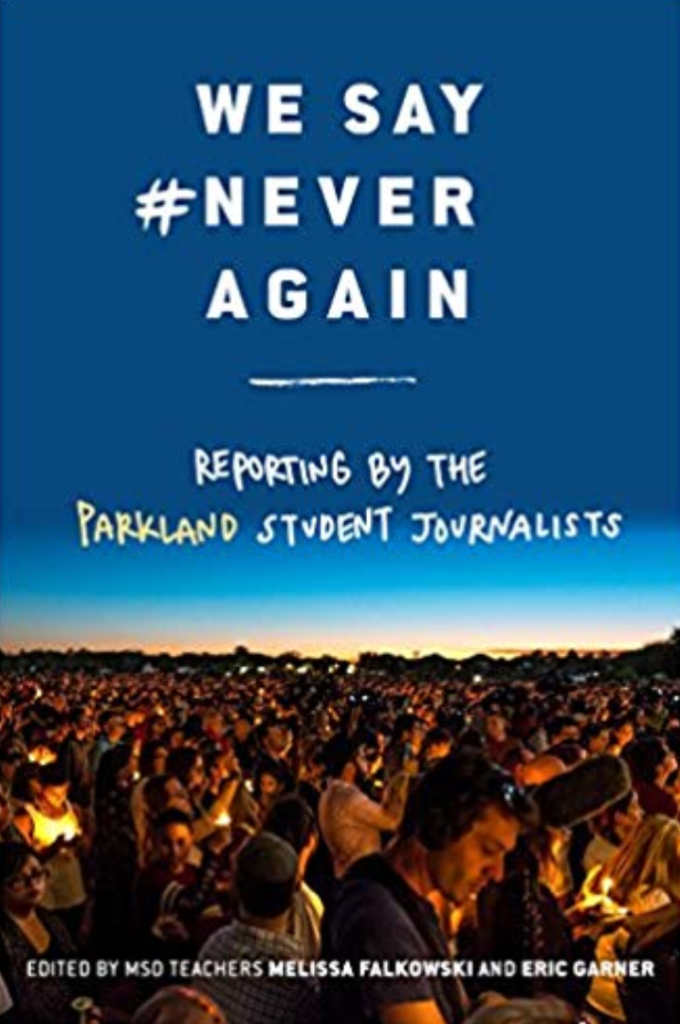Book Review: We Say #NeverAgain – Reporting by the Parkland Student Journalists
By F. Chris Curran
Just over a year ago, on February 14th, 2018, the lives of students at Parkland, FL’s Marjory Stoneman Douglas High School were shattered by the violence of a mass school shooting. The Parkland shooting would draw national attention, much as previous events like the tragedies at Columbine High School and Sandy Hook Elementary had in years before. And, sadly, it would become a backdrop for a number of other school shootings, including that in Santa Fe, Texas, that would occur before the year was through.
The Parkland shooting, however, has emerged as unique for how students responded and engaged after the shooting. Students from Stoneman Douglas High have entered the national spotlight through media engagement, ventured into the political process as policymakers considered responses to the tragedy, taken on a leading role in events like March for our Lives, and have generally been vocal parts of the narrative and response to the shooting.
This level of engagement by students contrasts with prior mass shootings. Whether in virtue of the age of the students (elementary students at Sandy Hook) or the accessibility of venues for finding voice (Columbine occurring prior to social media), the response to Parkland has a uniquely student-driven component that we have rarely seen in the past
Student Voice in New Book

This voice has been captured nicely in a book I recently picked up at my local library. Edited by the journalism and media teachers of Stoneman Douglas High and featuring the writings of their students, We Say #NeverAgain, brings the voice of the students to the forefront in a way unfettered by the media or interest groups.
Through a series of short narratives, the student reporters of Stoneman Douglas High chronicle the tragedy of the shooting, the acts of heroism by those present, insights into the aftermath and efforts to move forward, and views on the role of students as speakers for those lost and as activists for polices that might prevent future tragedies. It is a powerful book that cuts through the perception of the event as just “another school shooting”, bringing to light the human loss and ongoing grief of those affected.
For example, the book describes the actions of the first student to encounter the shooter, who escaped and notified school staff. It describes a teacher holding a door shut as the shooter tries to open it, all to give students time to escape. It provides firsthand accounts of the feelings of grief, anger, and guilt felt by many students while also detailing the duty felt by the student journalists to tell the story. It provides insights for reporters covering such tragedies as well as for students who seek to raise their voice in social activism. In all of these, it is raw, real, and well written.
Implications for Researchers
As a researcher who studies school safety, the book is also a reminder of both the importance of the work we do but also that such work is about and has effects on real people.
Over the past year, I have experienced an increasing interest in my work on school safety. As a researcher who seeks to inform policy and practice and drive real, positive change for students and schools, the opportunity to have my work shared more widely is gratifying. Opportunities to be interviewed for radio or television, invitations to give talks, and interest in my published research are exciting professional moments.
Yet, these moments must be put into perspective. Several times over the last year, I have had others describe my research in terms that make me uncomfortable – such as when someone introduced my work as “sexy”. In their book, the student journalists from Parkland struggle with similar feelings. They have been given opportunities to appear in the media, to meet famous celebrities, and to push policy agendas that can improve school safety. Yet, these opportunities have arisen through the loss of 17 of their classmates and school staff.
As researchers, then, the voice of Parkland students is a reminder that these events are more than convenient hooks for our research. These events are about real people, and the loss of real people. It is important that the attention to the work we do not overshadow the reason for the work, which is promoting the lives and well-being of real people.
What is encouraging to me is that We Say #NeverAgain is a story of hope in young people and therefore hope in the future. Whether through accounts of students saving classmates in the moment of the shooting, comforting grieving peers in the weeks afterward, or launching national movements to address gun violence, the stories in this book give a hopeful view of a better future. It demonstrates how, in spite of tragedy, young people can rise above to find empowerment to speak out, influence policy, and drive change. For those working in this space, these are voices worth hearing, and this book is a powerful way of doing so.
You can learn more about the book here.